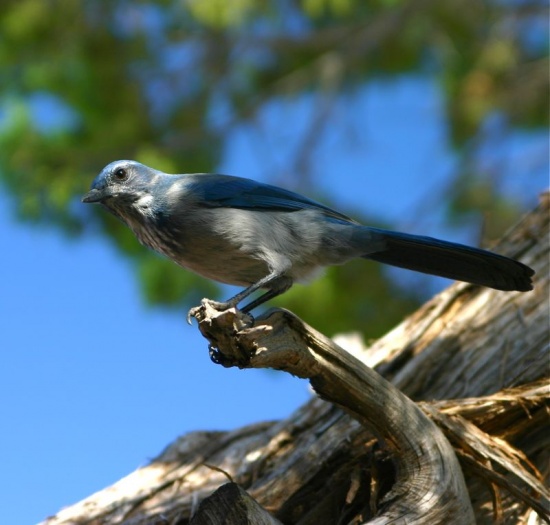(split by IOC and Clements) |
m |
||
| Line 21: | Line 21: | ||
Seven subspecies in two groups recognized: | Seven subspecies in two groups recognized: | ||
*'''Woodhouses's Scrub Jay''': | *'''Woodhouses's Scrub Jay''': | ||
| − | :*''A. | + | :*''A. w. nevadae'': southeastern Oregon south through Great Basin to northeastern Sonora and northwestern Chihuahua |
| − | :*''A. | + | :*''A. w. woodhouseii'': from the Rocky Mountains to western [[Oklahoma]], western [[Texas]] and northern Chihuahua |
| − | :*''A. | + | :*''A. w. texana'': west-central Texas |
| − | :*''A. | + | :*''A. w. grisea'': northwestern [[Mexico]] (eastern slopes of Sierra Madre Occidental) |
| − | :*''A. | + | :*''A. w. cyanotis'': mountains of east-central Mexico (southern Coahuila and Nuevo León to Hidalgo) |
*'''Sunichrast's Scrub Jay''': | *'''Sunichrast's Scrub Jay''': | ||
| − | :*''A. | + | :*''A. w. sumichrasti'': highlands of southern Mexican plateau (Veracruz to Puebla and Oaxaca) |
| − | :*''A. | + | :*''A. w. remota'': southwestern Mexico (Sierra Madre del Sur of Guerrero) |
==Habitat== | ==Habitat== | ||
*The ''woodhouseii'' group has a preference for pinyon-juniper woodland but is also found in open oak and pine-oak woodlands. | *The ''woodhouseii'' group has a preference for pinyon-juniper woodland but is also found in open oak and pine-oak woodlands. | ||
Revision as of 17:13, 17 August 2016
Alternative name: Sumichrast's Scrub Jay (sumichrasti group)
- Aphelocoma woodhouseii
Identification:
Length 27-31 cm (11-13"), wingspan 38-40 cm, weight 70-100 g.
- Large, strong bill (slenderer than California Scrub Jay)
- Long tail, make it appear larger than it is
- Head, wings, and tail blue
- Gray to gray-brown back
- Light gray underparts
- Dusky face mask
- White throat offset by incomplete blue necklace (diffusely defined)
- sumichrasti and remota are larger, have bluer backs, whiter throats and a hooked bill
Similar species
Less contrasting breast band and thinner bill without hook near the tip compared to California Scrub Jay.
Distribution
Occurs in the Great Basin and the southern Rocky Mountains in the USA, and the Sierra Madre chains in northern Mexico.
Taxonomy
Island Scrub Jay, Florida Scrub Jay and California Scrub Jay were formerly considered conspecific.
Subspecies
Seven subspecies in two groups recognized:
- Woodhouses's Scrub Jay:
- A. w. nevadae: southeastern Oregon south through Great Basin to northeastern Sonora and northwestern Chihuahua
- A. w. woodhouseii: from the Rocky Mountains to western Oklahoma, western Texas and northern Chihuahua
- A. w. texana: west-central Texas
- A. w. grisea: northwestern Mexico (eastern slopes of Sierra Madre Occidental)
- A. w. cyanotis: mountains of east-central Mexico (southern Coahuila and Nuevo León to Hidalgo)
- Sunichrast's Scrub Jay:
- A. w. sumichrasti: highlands of southern Mexican plateau (Veracruz to Puebla and Oaxaca)
- A. w. remota: southwestern Mexico (Sierra Madre del Sur of Guerrero)
Habitat
- The woodhouseii group has a preference for pinyon-juniper woodland but is also found in open oak and pine-oak woodlands.
- The sumichrasti group occurs in a variety of open woodland and brushy environments.
Behaviour
Like all jays, this species may be secretive and silent around its nest or while perching in a treetop in early morning but is frequently noisy and conspicuous.
Flight
Glides in a long, undulating flight.
Diet
Omnivorous, eating a wide range of large seeds (particularly acorns and pinyon seeds), large insects and arthropods, eggs and young of other birds, small rodents, and similar.
Breeding
The clutch consists of 3-6 eggs, spotted on darker, greenish or reddish base, in a twiggy nest well hidden in a tree or dense shrub.
Vocalisation
Call: is loud, throaty jayy? or jree?
In flight: a long series of check-check-check notes. There are audible differences in vocalizations between the three groups.
References
- AOU proposal including a discussion of possible split of the three groups, read August 2009
- Clements, J. F., T. S. Schulenberg, M. J. Iliff, D. Roberson, T. A. Fredericks, B. L. Sullivan, and C. L. Wood. 2016. The eBird/Clements checklist of birds of the world: v2016, with updates to August 2016. Downloaded from http://www.birds.cornell.edu/clementschecklist/download/
- Gill, F and D Donsker (Eds). 2014. IOC World Bird Names (version 4.3). Available at http://www.worldbirdnames.org/.
- audubonbirds.org
- Birdforum thread discussing the taxonomy of this species
Recommended Citation
- BirdForum Opus contributors. (2024) Woodhouse's Scrub Jay. In: BirdForum, the forum for wild birds and birding. Retrieved 27 April 2024 from https://www.birdforum.net/opus/Woodhouse%27s_Scrub_Jay
External Links




